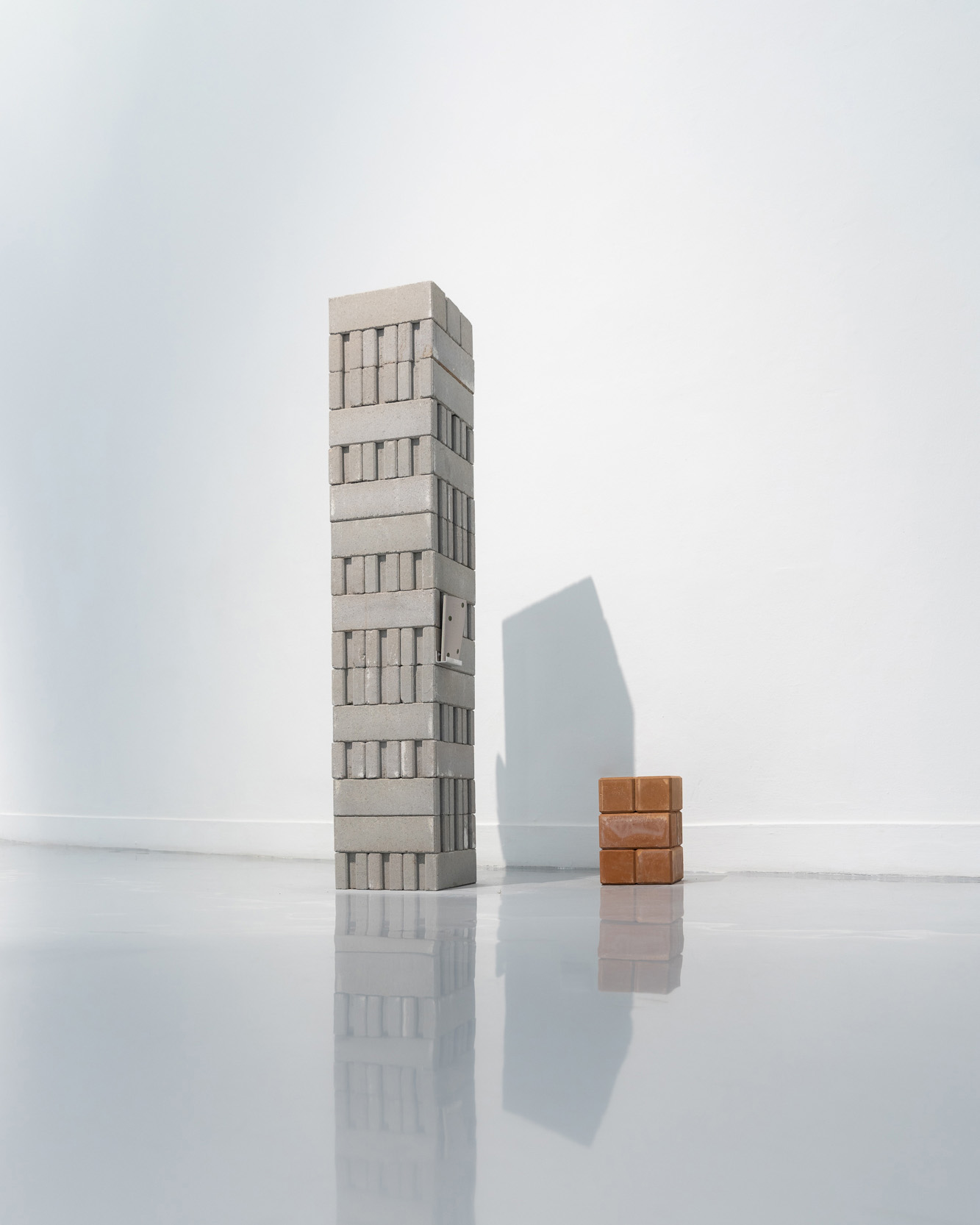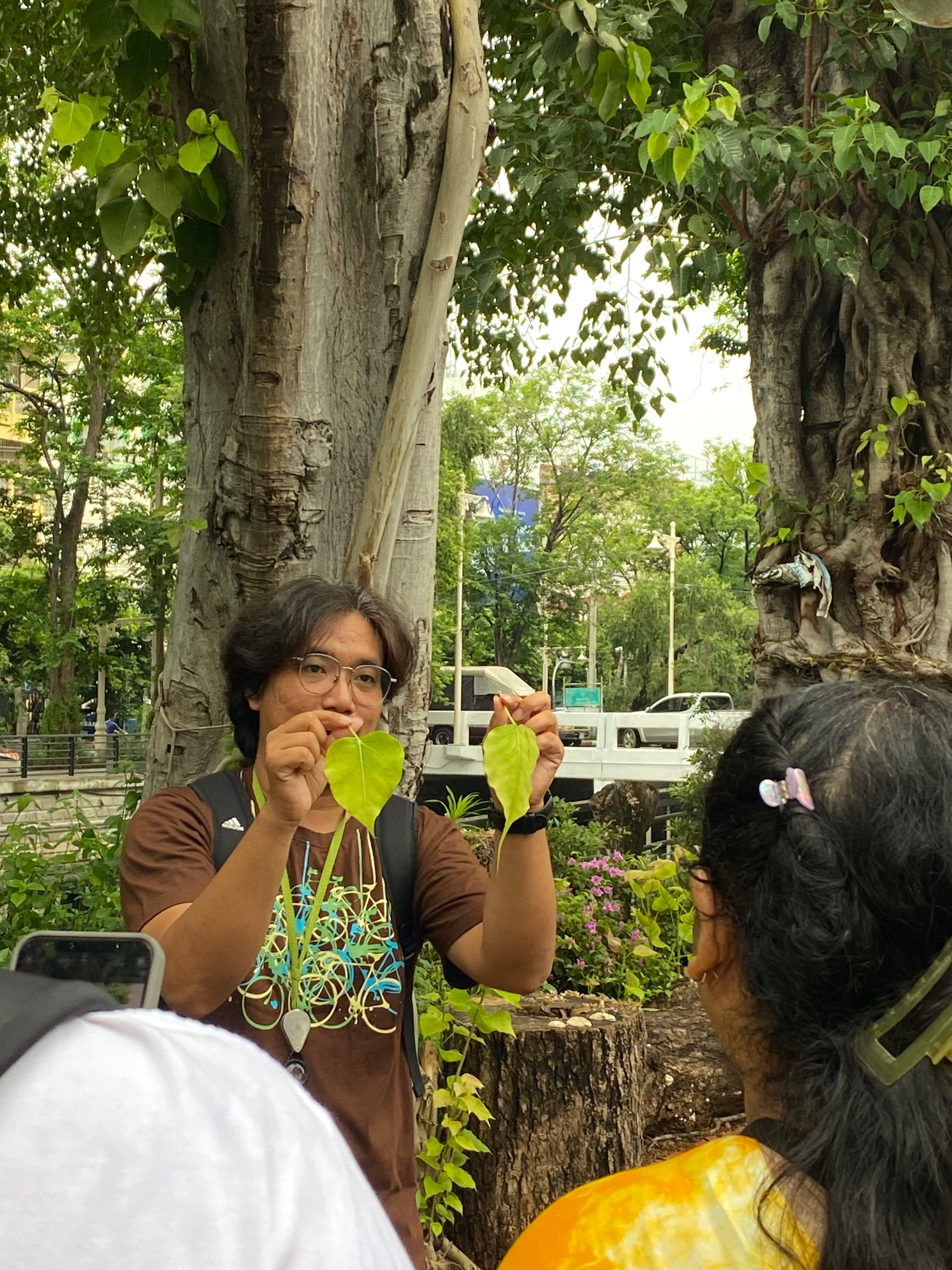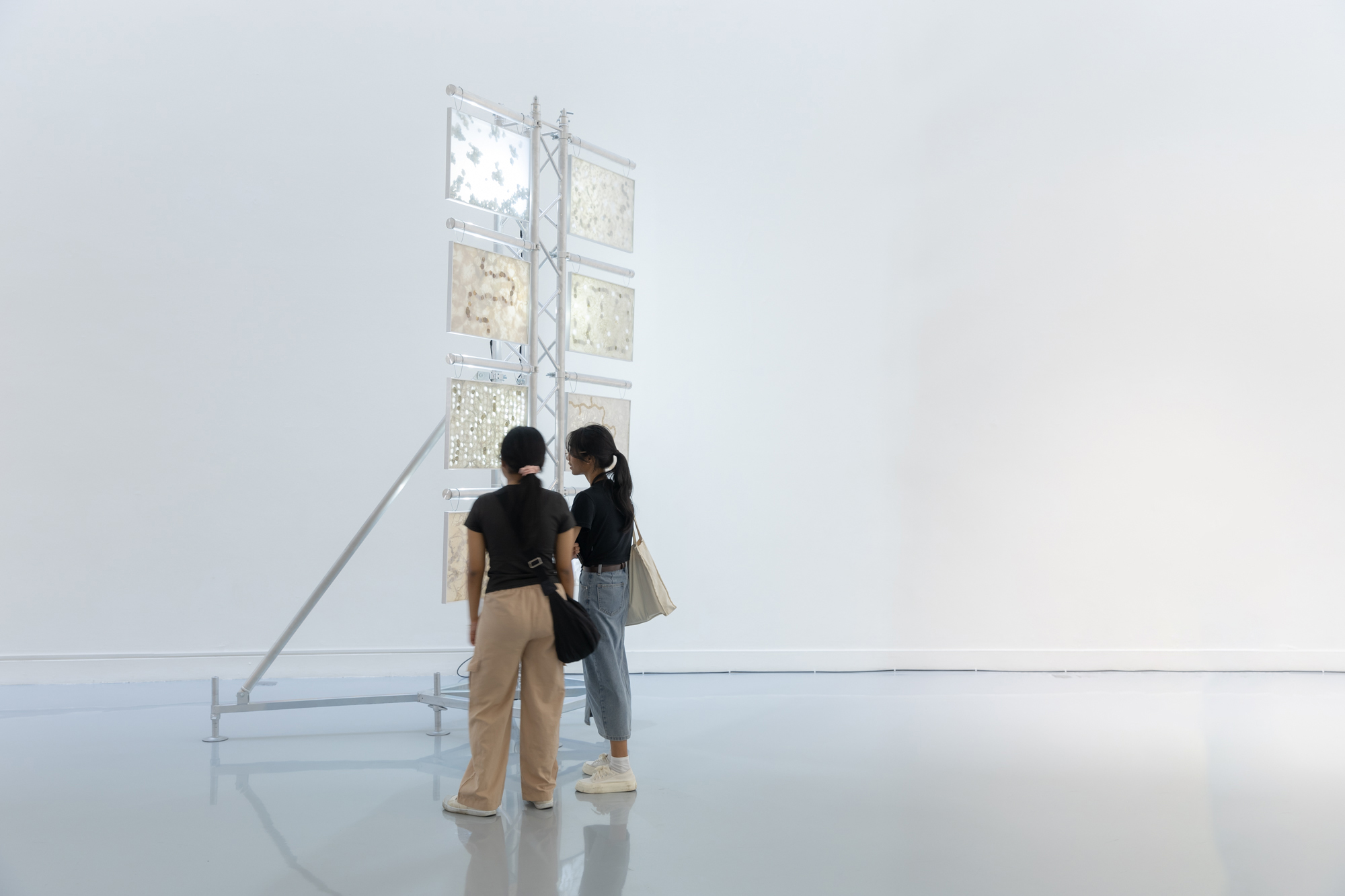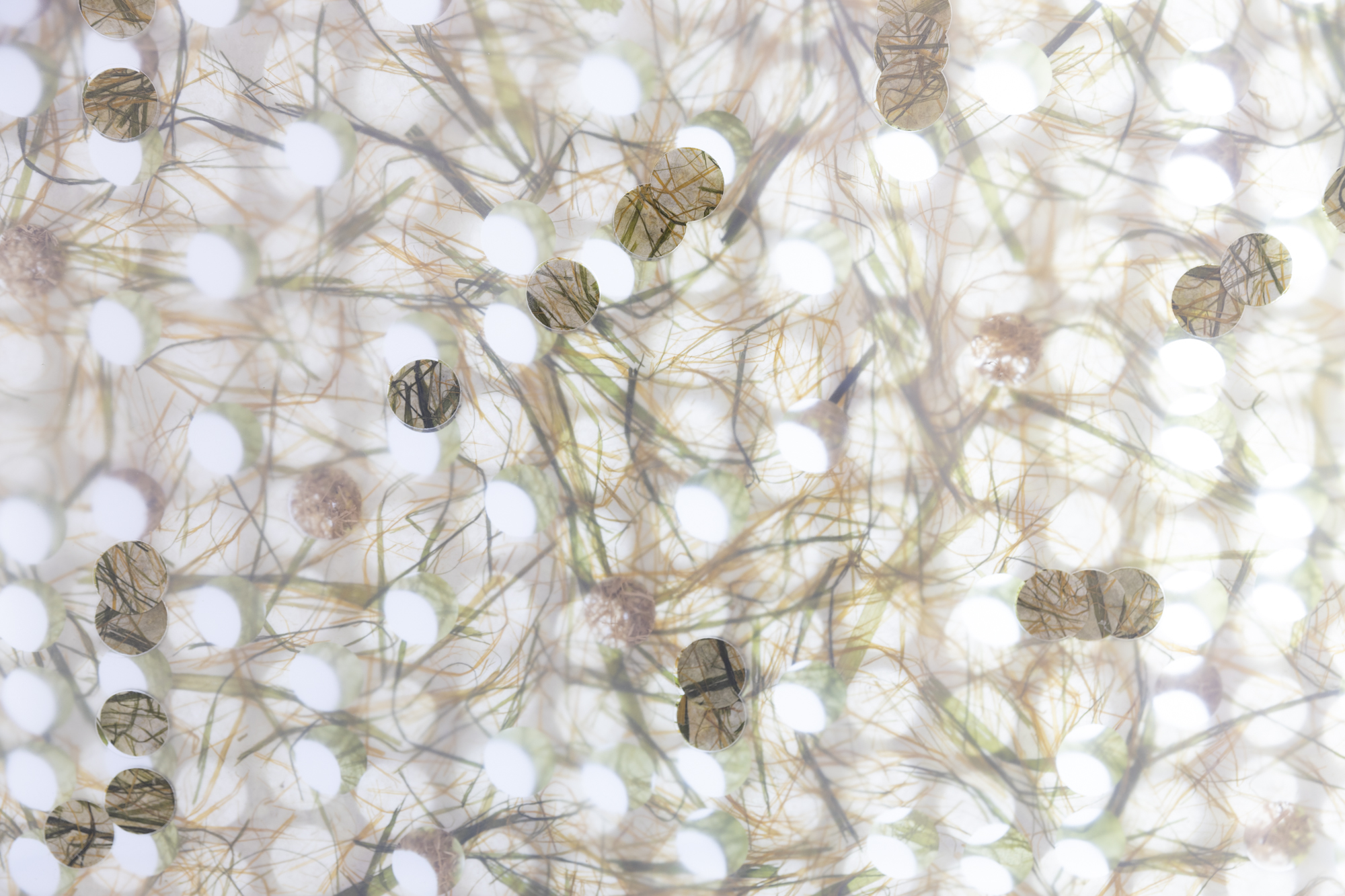
Unexpected Growth (2025)
Part of the Early Years Project 8
Exhibited at the 7th Floor Gallery, Bangkok Art and Culture Centre
March 27 – June 29, 2025
This series of works began with my attempt to understand and question the connection between the surrounding environment and inner emotions—the desire to escape from or move beyond the present circumstances. I started by exploring the city I live in—a place that often feels arid and unyielding in its essence.
During this exploration, I encountered the perspectives of environmentalists, which revealed aspects of the city I had never noticed before. These included nearly invisible liverworts, the distinct and diverse sounds of animals heard beneath the canopy of a large tree, the relationship between mother and offspring plants spreading within urban communities, and the resilience of weeds struggling to grow in inhospitable spaces. These discoveries resonated deeply with my own feelings of perseverance and existence.
I spent time walking, collecting data, photographing, and gathering weeds to incorporate into my creative process. The experience made me feel like a bee recognizing a flower—once I saw something, I could never unsee it. This led me to experiment with making paper from weeds. In the process, I encountered limitations such as thickness, flexibility, and size, which led me to seek guidance from paper-making experts. Through this, I came to see paper not merely as a finished material but as part of a process intrinsically connected to its origins.
With this series, I hope to encourage viewers to take the time to observe the works, to question the origins of materials and techniques, and to see them through the same lens as noticing the often-overlooked in daily life. By paying attention to the ground, the walls, and human-made structures, one may begin to perceive the hidden connections within everything around them. This shift in perspective reveals new possibilities beyond familiar frameworks, bringing objects and people closer together and uncovering the deep interconnections of existence, growth, and emergence—whether in nature, in constructed spaces, or within ourselves.
With gratitude to those who supported this work
Urban biodiversity walk reference: Green World Foundation
Papermaking reference and production: Kozo Studio ,Jirath Luamarin (P, Kae)
Translation: Nawakorn Wattanasiri
Photography: BACC ,Patcharapa Pipatnudda
Part of the Early Years Project 8
Exhibited at the 7th Floor Gallery, Bangkok Art and Culture Centre
March 27 – June 29, 2025
This series of works began with my attempt to understand and question the connection between the surrounding environment and inner emotions—the desire to escape from or move beyond the present circumstances. I started by exploring the city I live in—a place that often feels arid and unyielding in its essence.
During this exploration, I encountered the perspectives of environmentalists, which revealed aspects of the city I had never noticed before. These included nearly invisible liverworts, the distinct and diverse sounds of animals heard beneath the canopy of a large tree, the relationship between mother and offspring plants spreading within urban communities, and the resilience of weeds struggling to grow in inhospitable spaces. These discoveries resonated deeply with my own feelings of perseverance and existence.
I spent time walking, collecting data, photographing, and gathering weeds to incorporate into my creative process. The experience made me feel like a bee recognizing a flower—once I saw something, I could never unsee it. This led me to experiment with making paper from weeds. In the process, I encountered limitations such as thickness, flexibility, and size, which led me to seek guidance from paper-making experts. Through this, I came to see paper not merely as a finished material but as part of a process intrinsically connected to its origins.
With this series, I hope to encourage viewers to take the time to observe the works, to question the origins of materials and techniques, and to see them through the same lens as noticing the often-overlooked in daily life. By paying attention to the ground, the walls, and human-made structures, one may begin to perceive the hidden connections within everything around them. This shift in perspective reveals new possibilities beyond familiar frameworks, bringing objects and people closer together and uncovering the deep interconnections of existence, growth, and emergence—whether in nature, in constructed spaces, or within ourselves.
With gratitude to those who supported this work
Urban biodiversity walk reference: Green World Foundation
Papermaking reference and production: Kozo Studio ,Jirath Luamarin (P, Kae)
Translation: Nawakorn Wattanasiri
Photography: BACC ,Patcharapa Pipatnudda






















Path 01 — Walking the City
During my exploration, I discussed with environmentalists whose perspectives opened my eyes to unnoticed details—tiny liverworts, animal sounds under trees, the bond between mother trees and saplings, and weeds thriving in harsh conditions. These reflections echoed the struggle to exist, resonating with my own inner feelings.
During my exploration, I discussed with environmentalists whose perspectives opened my eyes to unnoticed details—tiny liverworts, animal sounds under trees, the bond between mother trees and saplings, and weeds thriving in harsh conditions. These reflections echoed the struggle to exist, resonating with my own inner feelings.
Path 02 — Paper from Weeds
Collecting weeds from the city to experiment with making paper. Using the entire weed—leaves, branches, stems, and roots—results in paper that is thick, firm, and rough, resembling cardboard or tanned leather. Using only the softer parts, such as leaves or soft weeds like Shiny Bush, produces thinner, more flexible paper, though less durable. The paper still retains traces of the weeds used, reminding me of where they grew.


Path 03 — A Journey to Meet the Paper-Making Expert
After experimenting with paper-making, I wanted to create larger, sturdier sheets and explore other techniques. A friend recommended visiting Kozo Studio in Sukhothai to meet experts in paper-making.
In the process, the experts shared something unexpected: mulberry trees grow easily without planting or watering, especially in the northern region. Although considered weeds, harvesting the bark requires careful planning—cutting the trees to knee-height, peeling and cleaning the bark, and sun-drying it. This process ensures new shoots will grow the following year.
After experimenting with paper-making, I wanted to create larger, sturdier sheets and explore other techniques. A friend recommended visiting Kozo Studio in Sukhothai to meet experts in paper-making.
In the process, the experts shared something unexpected: mulberry trees grow easily without planting or watering, especially in the northern region. Although considered weeds, harvesting the bark requires careful planning—cutting the trees to knee-height, peeling and cleaning the bark, and sun-drying it. This process ensures new shoots will grow the following year.






To improve the strength of the paper made from weeds, I was introduced to blending it with other types of plant fibers. With the help of P’Kae and the team at Kozo Studio, a miniature paper-making station was set up to simulate the real production process. They helped refine the technique and develop the paper to match my vision—firm yet flexible, textured yet workable.
A microscopic view of mulberry fibers showed how they interlace and bind with the weed pulp, reinforcing the structure and making the final sheet significantly stronger.
P’Kae also offered some advice for the future:
“If you want to improve the quality of the material, try looking for a mulberry tree in Bangkok. I bet you can find one growing by the street in less than an hour. Check the leaves—each tree has two types: one with three points and one that’s round. You’ll usually find them in areas where people live and the air is moist. The plant spreads naturally through its roots and underground buds from the mother tree. Once you know what to look for, you’ll start seeing them everywhere.”
A microscopic view of mulberry fibers showed how they interlace and bind with the weed pulp, reinforcing the structure and making the final sheet significantly stronger.
P’Kae also offered some advice for the future:
“If you want to improve the quality of the material, try looking for a mulberry tree in Bangkok. I bet you can find one growing by the street in less than an hour. Check the leaves—each tree has two types: one with three points and one that’s round. You’ll usually find them in areas where people live and the air is moist. The plant spreads naturally through its roots and underground buds from the mother tree. Once you know what to look for, you’ll start seeing them everywhere.”









Path 04 — Material to Simulation
Transforming findings into a reflective work—connecting material, place, time, emotions, and people.
The installation begins by recreating an environment resembling a city, where tiny weeds grow in overlooked spots—near water, animals, and people. It reflects the feeling of discovery—finding something that is struggling to survive and evolve after intentionally looking for it. The final piece transforms these once-ignored weeds into something prominent—now seemingly everywhere, just like how we start noticing them after the project begins.
Path 05 — A book hidden within the work, revealing unseen and unnoticed connections.
Swipe to flip the page to read above.
Swipe to flip the page to read above.
